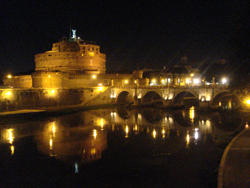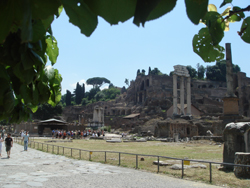Sites dating from the Ancient Rome are dotted all over the city so it's pretty much impossible for me to cover everything on this page. This is, however, a small collection of highlights which I reckon you shouldn't miss.
-
 Colosseum -
the Colosseum is probably the most iconic symbol of
Rome
and
ancient Roman and an absolute must see for visitors to
Rome.
There
are many tour guides touting for business outside the
Colosseum - find Aldos' group (they wear blue id cards)
- for the best tours.
Colosseum -
the Colosseum is probably the most iconic symbol of
Rome
and
ancient Roman and an absolute must see for visitors to
Rome.
There
are many tour guides touting for business outside the
Colosseum - find Aldos' group (they wear blue id cards)
- for the best tours. -
Roman Forum - the Roman Forum is possibly what most people think of when thinking of Rome and is now one of the major attractions of Rome itself. Home to Saturns Temple, the Arch of Septimus Severus, the Arch of Titus and the enormous Basilica of Maxentius - the latter would provide the inspiration for later religous Basilica.
-
Baths of Caracalla - Baths were central to Roman life and the Baths of Caracalla are amongst the most well preserved in Rome itself. Baths were an important part of Roman life - but I didn't realise how large they were until I visited Caracallas baths. Much of the walls are still preserved and there was even a library in the Terme di Caracalla. Take the excellent audio-guide to take you through the history and structure of the baths.
-
Pantheon - the Pantheon (or Temple to All The Gods) is the oldest domed structure standing in Rome Built under the rule of either Trajan or Hadrian the Pantheon was once a temple to all the Roman Gods but has served as a Roman Catholic Church since the 7th century.
-
 Palatine
Hill and Casa di Augusto - The Palatine Hill is,
according to leged, the hill on which
Rome
was
founded by Romulus and Remus who were raised here by
a she-wolf. As the most sacred hill in
Rome,
Augustus
built his enormous palace here which can still be visited
including an enormous games room. Augustus House (Casa
di Augusto,) was the home of the first Roman Emporer
Augustus. Restored and reopened to the public in March
2008, the Casa di Augusto boasts some of the oldest
frescoes in
Rome.
Palatine
Hill and Casa di Augusto - The Palatine Hill is,
according to leged, the hill on which
Rome
was
founded by Romulus and Remus who were raised here by
a she-wolf. As the most sacred hill in
Rome,
Augustus
built his enormous palace here which can still be visited
including an enormous games room. Augustus House (Casa
di Augusto,) was the home of the first Roman Emporer
Augustus. Restored and reopened to the public in March
2008, the Casa di Augusto boasts some of the oldest
frescoes in
Rome.
-
Case Romane del Celio - The Roman Houses, which include houses, shop and a road section, cuts through the foundations of Church of Santi Giovanni e Paolo which was built on top of the houses. Traditionally dated to the 4th Century, this site was reopened in 2002 and the section is surprisingly complete and provides an interesting insight into structure of the houses and roads of the time.
-
Domus Aurea and Trajans Baths - The Domus Aurea ("Golden House") was originally elaborately decorated, including gold leaf which gave the house it's name, the villa was built on the Esquiline Hill between the Great Fire of Rome in 64 AD and Neros suicide in 68 AD. After Neros death, Vespasian, Titus and Domitian built over his palace with their forms of architecture. Trajan covered the last of the palace and built his baths on top.
-
 Castel
Sant'Angello - Originally built as the mausoleum
for the Emporer Hadrian, the Castel Sant'Angello was
later substanially expanded and modified to serve as
a Papal fortresss. Although most of the contents of
the tomb were destroyed the cylindrical shape of the
mausoleum is quite clear when ascending the ramp on
the interior of the Castle. There are excellent views
of town to be had from the various platforms on top
of the castle.
Castel
Sant'Angello - Originally built as the mausoleum
for the Emporer Hadrian, the Castel Sant'Angello was
later substanially expanded and modified to serve as
a Papal fortresss. Although most of the contents of
the tomb were destroyed the cylindrical shape of the
mausoleum is quite clear when ascending the ramp on
the interior of the Castle. There are excellent views
of town to be had from the various platforms on top
of the castle.






